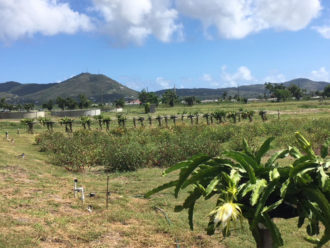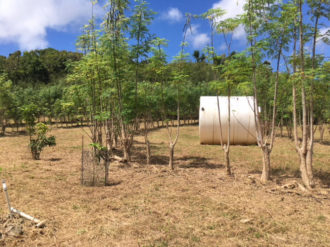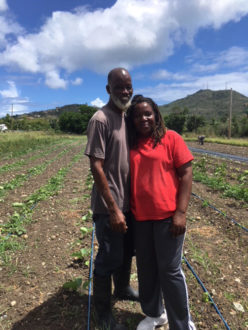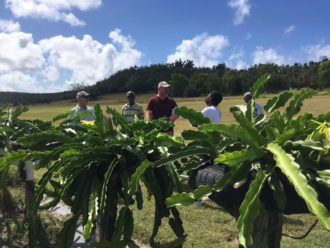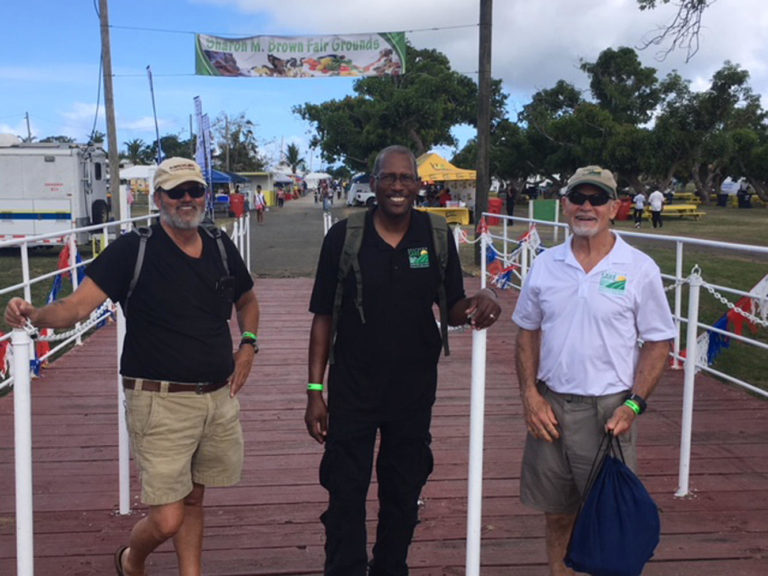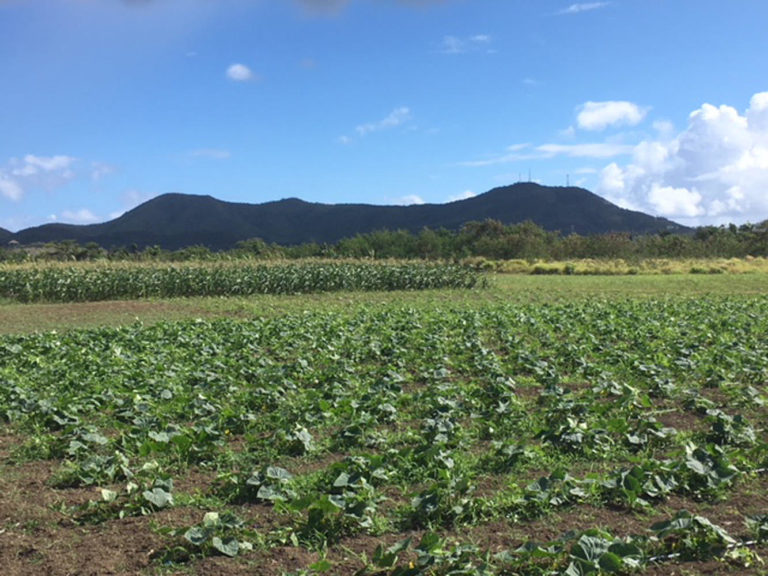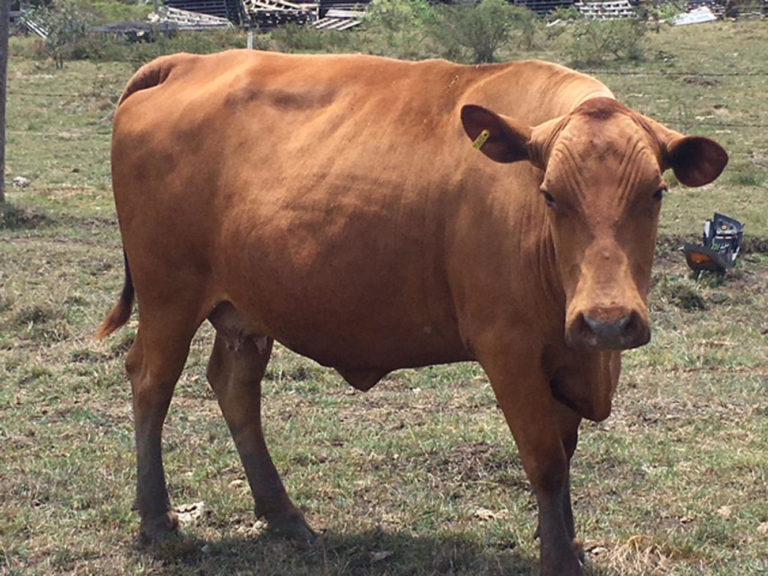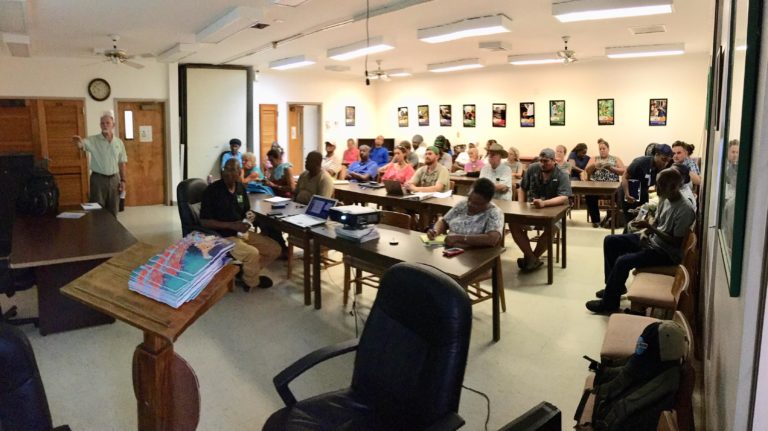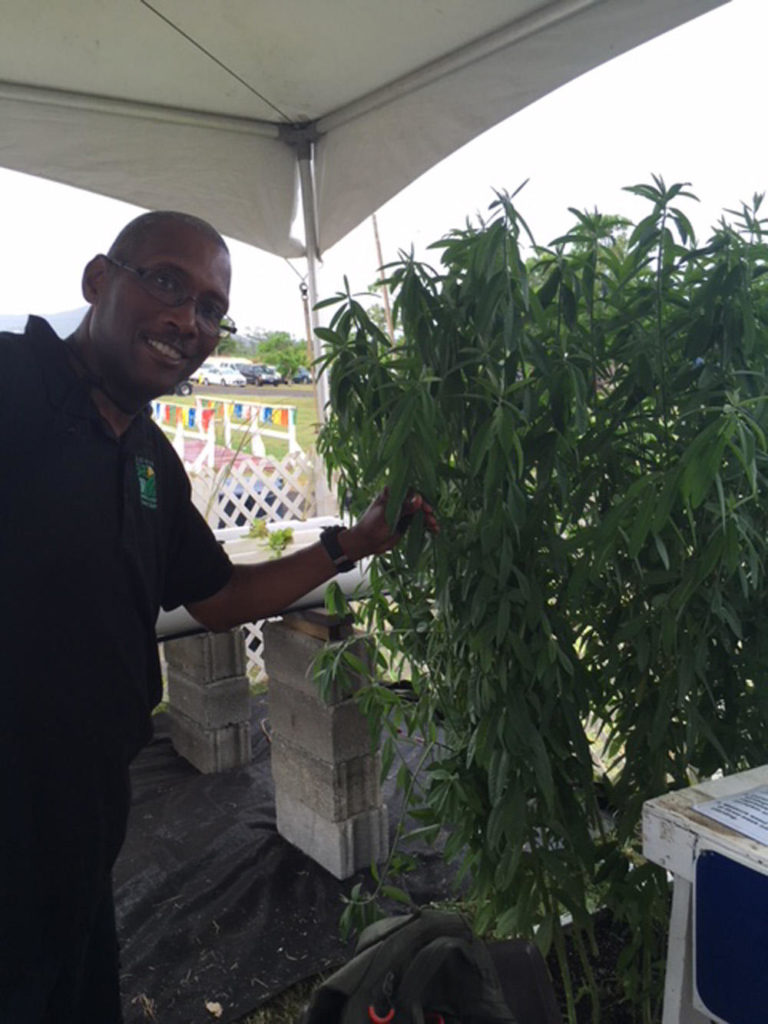CHRISTIANSTED, St. Croix – For months, a 14,000-gallon water tank has been sitting on its side in the middle of Frederick Miller’s Moringa tree orchard. Winds from Hurricane Maria had rolled the tank down the hillside of his farm, and he still hasn’t figured out yet how he’s going to move it.
Yvette and Dale Brown of Sejah Farm pride themselves on a diverse farming operation, growing a wide variety of vegetables and raising livestock, such as sheep. But the fenced area that once housed their chickens remains empty. Their flocks, swept away from the hurricane, have not yet been replaced.
Greenhouses line the agricultural grounds at the University of Virgin Islands Ag Experiment Station. Used for plant-based research projects, all that is left of the once solid structures are their skeletal remains. They are unusable. And orchards of fruit trees earmarked for research on campus are gone, wiped away by 200-mph winds.
Images of agriculture across the U.S. Virgin Islands are the same. Damaged structures, lost livestock, failed crops, piled debris. Nine months after Hurricanes Maria and Irma cut a swath of destruction across St. Croix, St. Thomas and St. John, normalcy is not a foregone conclusion. And hurricane season has begun again.
An outreach team with the Southern Sustainable Agriculture Research & Education (SSARE) program visited St. Croix and St. Thomas recently to meet with university administrators, faculty and staff, and farmers to better understand agriculture on the islands. The purpose of the trip was to raise awareness of the SARE program and outline ways ag professionals can collaborate and connect on sustainable agriculture production and marketing practices through educational or research opportunities.
In SARE’s 30-year history, the U.S. Virgin Islands has received the fewest number of research grants: only seven, totaling $917,380. The reasons behind the low numbers are varied and emphasize just how challenging agriculture is on the islands.
- Land for agriculture is hard to come by, and expensive. Owned by either the government or private landowners, farmland is generally in a tenant situation.
- Island infrastructure is antiquated, making advancements in farming technology out of reach for many farmers. Electricity, for example, is expensive (about 5 times what it is on the U.S. mainland), so processes like cold storage that would expand marketing opportunities for farmers are generally out of reach financially.
- There is no agriculture “industry” on the islands. The U.S. Virgin Islands was once one of the top-producing sugar cane nations in the world, but the last of the plantations was driven out of business a few decades ago by other manufacturing endeavors. Farms on St. Croix and St. Thomas are few (a few hundred at most) and small (generally less than 10 acres), meaning that resources and support are limited.
- While the University of Virgin Islands does lead agricultural research in and collaborates with its Cooperative Extension Service, the university does not offer agricultural degree programs, making it difficult to prepare the next generation for agriculture on the islands.
- Water is a limiting factor. The U.S. Virgin Islands is a dry tropical territory; the islands generally receive around 40 inches of rainfall, and that’s confined to only a few months out of the year. Droughts are a problem because the islands are dependent on rainfall as a water source. As such, vegetable production is entirely dependent on irrigation, collected through such services as rainwater catchment systems, shallow wells, or ponds. Limited water means challenging crop and livestock production.
- The islands are dominated by caliche soils, rock fragments and fine-grained sediments that are “cemented” together by mineral particles, such as calcium carbonate. This soil type creates problems of poor soil drainage, poor growth conditions for crops, and other production issues.
Despite such limitations, agriculture on the U.S. Virgin Islands is prevailing and, in fact, these challenges are paving the way for more sustainable ag practices.
Renewable resources, specifically solar panels, are becoming more prevalent as an alternative to aging infrastructure.
Produce and livestock stay local; farmers markets and roadside stands are a major means of marketing. An abattoir on St. Croix services all manner of livestock, from goats to sheep to pigs.
Keeping harvests local also creates a sense of community. After Hurricane Irma hit St. Thomas hard, Sejah Farm temporarily closed their roadside markets and shipped over 8,000 pounds of produce to the island to ensure that residents had access to healthy food.
Local food systems are creating demand from grocery stores, restaurants and resort hotels, creating opportunities for niche products – crops like dragon fruit – and value-added products, from coconut oil to hot sauces to fragrant soaps.
The answer to water and soil issues may lie in conservation practices, such as no-till and cover crops. University of Virgin Islands agronomist Stuart Weiss has been leading efforts to educate farmers on implementing such practices in their farming operations, even receiving a few Southern SARE research grants along the way to help with the process.
Weiss has been working with several farmers on St. Croix with conservation practices to improve soils, conserve water, manage weeds, and increase farm biodiversity.
In a SSARE-funded On-Farm Research project (OS11-062), “Promoting Tropical Cover Crop Mulch Systems for Minimum-Till Crop Production in the U.S. Virgin Islands,” Yvette and Dale Brown of Sejah Farms conducted and demonstrated cover crops research. They specifically incorporated sorghum sudangrass, lab lab and sunn hemp into a vegetable crop rotation to determine which cover crops produced the highest biomass for weed suppression. They found that sunn hemp provided the greatest level of weed suppression as a cover crop, producing enough biomass to choke out weed development for six weeks following cover crop termination by roller crimper.
Farmer Frederick Miller uses contour farming techniques along sloped land as conservation buffers to conserve soil and water. He has found that the conservation practices better support fruit tree production and greater farm biodiversity in comparison to crop production on the more level portions of his farm property.
Grantley Samuel of GLG Plants and Produce rotates cover crops into his diverse vegetable crop production of sweet corn, okra, and cucumbers. He’s seen positive results with moisture conservation and increased yields.
Weiss is also encouraging livestock producers to incorporate cover crops into their pasture rotations for increased forage options, especially in times of drought. One such farmer is Frank Bermudez, who operates a 40-acre Senepol cattle operation on the south side of St. Croix, a part of the island that receives little rainfall and is currently experiencing a drought. Low rainfall conditions and heavy grazing don’t give the native grasses time to recover, said Weiss. Incorporating a high-protein cover crop into a rotational grazing operation gives cattle an additional forage source and time for native grasses to adequately recover when water is scarce.
The takeaway from the SARE Outreach Team visit to the U.S. Virgin Islands is that while many of the challenges that farmers face are daunting, there are promising solutions that are being explored through relationship-building; partnership development; a focus on research priority areas, such as weather risk management; educational efforts; enterprise implementation; and the expansion of existing sustainable agriculture endeavors.
Published by the Southern Region of the Sustainable Agriculture Research and Education (SARE) program. Funded by the USDA National Institute of Food and Agriculture (NIFA), Southern SARE operates under cooperative agreements with the University of Georgia, Fort Valley State University, and the Kerr Center for Sustainable Agriculture to offer competitive grants to advance sustainable agriculture in America's Southern region. This material is based upon work that is supported by the National Institute of Food and Agriculture, U.S. Department of Agriculture, through Southern Sustainable Agriculture Research and Education, under sub-award number: OS11-062. USDA is an equal opportunity employer and service provider. Any opinions, findings, conclusions, or recommendations expressed in this publication are those of the author(s) and do not necessarily reflect the view of the U.S. Department of Agriculture.
